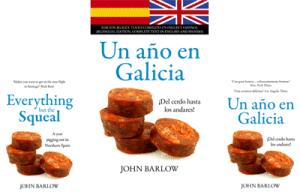 Years ago, when I was learning Spanish, I used to read a book of Spanish short stories published by Penguin. Twenty-odd years later, it’s still in print.
Years ago, when I was learning Spanish, I used to read a book of Spanish short stories published by Penguin. Twenty-odd years later, it’s still in print.
All the stories in it are by great Spanish writers. But that’s not why I read them; apart from anything else, my Spanish in those days was nowhere near good enough to appreciate their literary quality.
I read them because they came with parallel translations in English; Spanish on the left page, English on the right. In theory you could read a line in the original then jump across to the English version and check how you were doing. Even if you don’t like jumping, you always have the translation to see how you’re doing.
I still have the book, and I still read it occasionally. There’s something reassuring about having a full translation at your fingertips when you read in a foreign language, the idea that you won’t be left stranded if a tricky verb construction simply defeats you at a key moment in the story, ruining everything. These days parallel bilingual books for kids are pretty common, but not so much for adults.
Recently I decided to publish a Spanish language translation of my non-fiction book Everything but the Squeal, a food-based travelogue about Northern Spain. Given that I already had the English language e-rights (which the various publishers of the book kindly reverted), plus a Spanish translation, it occurred to me that I could bring out a bilingual version. But who would be interested?
Well, at the moment there doesn’t seem to be a simple and effective way of doing parallel pages in two languages on eBooks (another small advantage of the print book…). So, it would simply be a matter of having two versions of the book, one after the other, in the same eBook. Not quite as attractive to language learners, then, but something different at least.
A bilingual version is merely a matter of splicing the two eBooks together and tweaking the cover. However, is it worth doing? Who on earth might buy it? Well, the truth is I have no idea, but here are some suggestions:
1. Advanced students of either language.
2. Language teachers looking for a convenient source of texts for class work, including translations.
3. Someone who typically reads in one language but whose partner or friend might prefer the other.
4. People who speak one of the languages as a native, and the other one to only a modest degree, but who want to challenge themselves in their 2nd language (knowing that they have a fall back if they find it too difficult).
5. Bilingual readers who are simply attracted to owning a single book in both languages.
Is such a niche market likely to be big enough to justify the effort? Who knows. I certainly don’t. But for anyone who is already bringing out translations of their work, there’s nothing to lose. And if there is a market, then of course it’s potentially in both languages. With English-Spanish books, that’s a pretty big catchment, especially once Amazon opens up to South America.
So, let’s see.
I’ll let you know. // Os informaré.

I love this idea. Now I just need to learn another language. Nice post, John.
Very nice post, John, thanks. I live in Poland and the mainstreams at least do pretty good business with bilingual versions of children’s books; but you’re right, adults are expected to read either one version or the other.
Good luck with your plan – if the Spanish are anything like the Poles, you’ll have a good market there!
Cool idea. Buena suerte, John!
I teach ESL in Mexico and this is such a fantastic idea. Mucho suerte.